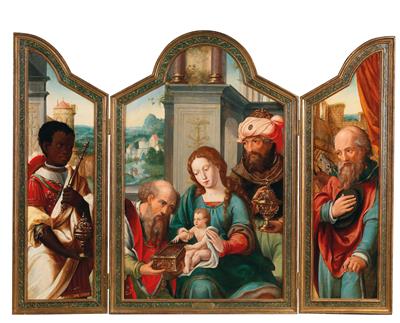Pieter Coecke van Aelst and Workshop

(Aelst 1502–1550 Brussels)
A Triptych: The Adoration of the Magi,
oil on panel, 96 x 128 cm (overall), 96 x 63 cm (central panel), 96 x 37 cm (left and right wing), framed
Provenance:
Collection Friedrich Kohn, Stuttgart;
with R. Finck, Brussels, 1964;
Collection Dieter Klenk (1906–1983), Mainz, 1964;
from whom purchased by the present owner in circa 1983
Literature:
G. Marlier, Pierre Coeck d’Alost, Brussels 1966, pp. 158/59, fig. 93
We are grateful to Till Holger Borchert for endorsing the attribution of the present lot to Pieter Coecke van Aelst and Workshop on the basis of a photograph.
The present composition is one of a number of known treatments of the Adoration of the Magi painted in either Brussels or Antwerp by Pieter Coecke van Aelst and his workshop. Others of note are in Utrecht, Museum Catharijneconvent (see G. Marlier, La Renaissance Flammande - Pierre Coeck d’Alost, Brussels, 1966, fig. 77), with a closely related, but not identical triptych sold at Dorotheum, Vienna, 20 October 2015, lot 29.
The inclusion of the figures of the wings into the scene of the central composition, constituted a novelty that opposed traditional practice, according to which the wings represented scenes that had nothing to do with the subject depicted at the centre. In this manner, a sense of generous spatiality and symmetry are lent to the present painting. This innovation was to later become a characterising feature of the works of artists of the next generation such as Joos van Cleve and the Master of the Female Half-Lengths.
In artistic tradition, Melchior, a middle-aged Magus, gives frankincense from his native Arabia, and is here represented by the turbaned figure with a neat beard standing behind Mary. Pieter Coecke van Aelst visited Constantinople and depicted the costumes of those he encountered en-route in a so called ‘woodcut frieze’ ingeniously cut from ten blocks, Ces Moeurs et fachons de faire de Turcz (published by his widow in 1553). Taken also from Coecke van Aelst’s travels, who according to Karel van Mander trained under the Brussels court painter Barend van Orley before sojourning in Rome, are presumably elements of the drawings the he made after both antique and modern architecture and sculpture. Van Aelst went so far as to translate both Vitruvius’s and Sebastiano Serlio’s architectural treatises into Flemish, as may be apparent from the pilasters depicted in the present lot.
Expert: Damian Brenninkmeyer
 Damian Brenninkmeyer
Damian Brenninkmeyer
+43 1 515 60 403
old.masters@dorotheum.com
30.04.2019 - 17:00
- Odhadní cena:
-
EUR 60.000,- do EUR 80.000,-
Pieter Coecke van Aelst and Workshop
(Aelst 1502–1550 Brussels)
A Triptych: The Adoration of the Magi,
oil on panel, 96 x 128 cm (overall), 96 x 63 cm (central panel), 96 x 37 cm (left and right wing), framed
Provenance:
Collection Friedrich Kohn, Stuttgart;
with R. Finck, Brussels, 1964;
Collection Dieter Klenk (1906–1983), Mainz, 1964;
from whom purchased by the present owner in circa 1983
Literature:
G. Marlier, Pierre Coeck d’Alost, Brussels 1966, pp. 158/59, fig. 93
We are grateful to Till Holger Borchert for endorsing the attribution of the present lot to Pieter Coecke van Aelst and Workshop on the basis of a photograph.
The present composition is one of a number of known treatments of the Adoration of the Magi painted in either Brussels or Antwerp by Pieter Coecke van Aelst and his workshop. Others of note are in Utrecht, Museum Catharijneconvent (see G. Marlier, La Renaissance Flammande - Pierre Coeck d’Alost, Brussels, 1966, fig. 77), with a closely related, but not identical triptych sold at Dorotheum, Vienna, 20 October 2015, lot 29.
The inclusion of the figures of the wings into the scene of the central composition, constituted a novelty that opposed traditional practice, according to which the wings represented scenes that had nothing to do with the subject depicted at the centre. In this manner, a sense of generous spatiality and symmetry are lent to the present painting. This innovation was to later become a characterising feature of the works of artists of the next generation such as Joos van Cleve and the Master of the Female Half-Lengths.
In artistic tradition, Melchior, a middle-aged Magus, gives frankincense from his native Arabia, and is here represented by the turbaned figure with a neat beard standing behind Mary. Pieter Coecke van Aelst visited Constantinople and depicted the costumes of those he encountered en-route in a so called ‘woodcut frieze’ ingeniously cut from ten blocks, Ces Moeurs et fachons de faire de Turcz (published by his widow in 1553). Taken also from Coecke van Aelst’s travels, who according to Karel van Mander trained under the Brussels court painter Barend van Orley before sojourning in Rome, are presumably elements of the drawings the he made after both antique and modern architecture and sculpture. Van Aelst went so far as to translate both Vitruvius’s and Sebastiano Serlio’s architectural treatises into Flemish, as may be apparent from the pilasters depicted in the present lot.
Expert: Damian Brenninkmeyer
 Damian Brenninkmeyer
Damian Brenninkmeyer
+43 1 515 60 403
old.masters@dorotheum.com
|
Horká linka kupujících
Po-Pá: 10.00 - 17.00
old.masters@dorotheum.at +43 1 515 60 403 |
| Aukce: | Obrazy starých mistrů |
| Typ aukce: | Salónní aukce |
| Datum: | 30.04.2019 - 17:00 |
| Místo konání aukce: | Wien | Palais Dorotheum |
| Prohlídka: | 20.04. - 30.04.2019 |
Všechny objekty umělce
